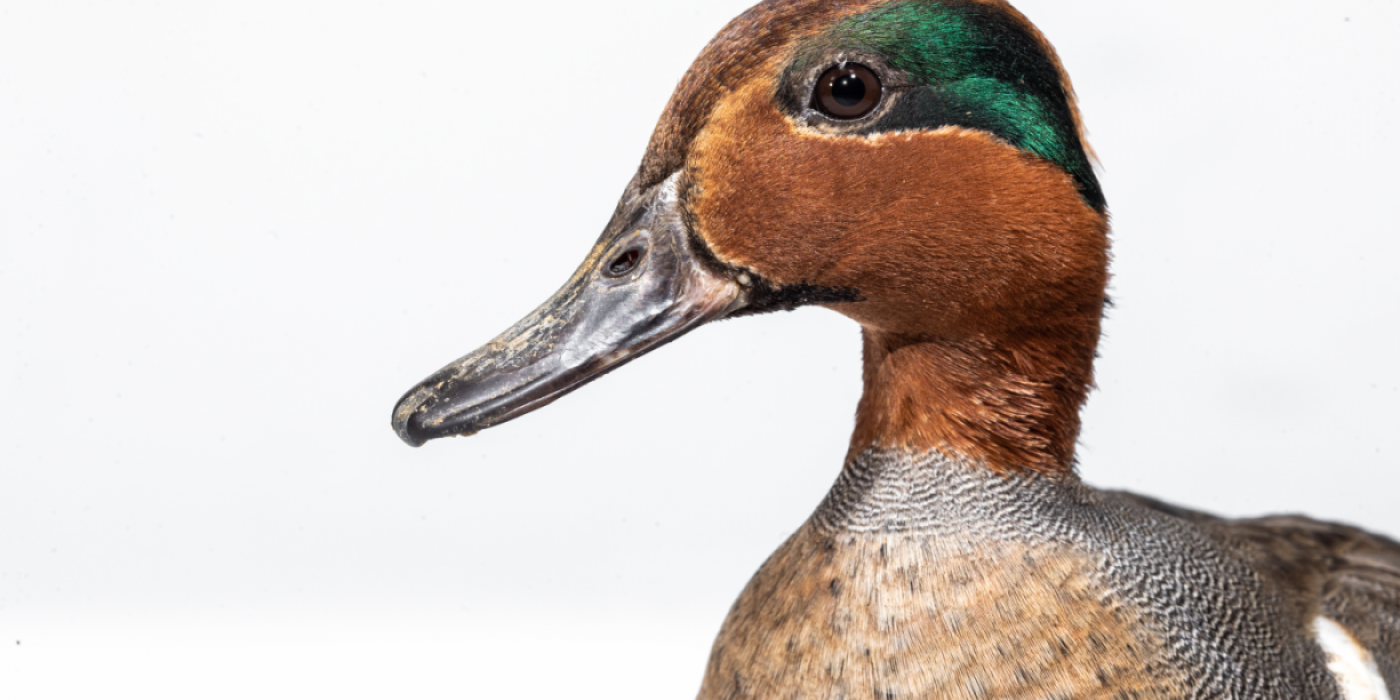Physical Description
Green-winged teals are small ducks named for the dark green coloration on their forewing, which can be seen when their wings are extended. This patch of color is known as a wing speculum.
Adult males are easy to distinguish from other ducks by the wide, dark green stripe on their heads. They have gray bodies with a narrow white stripe on their shoulders. Females’ bodies are mottled brown. They have a narrow black stripe around their eye and a smaller black strip around their bills.
Size
About the size of a crow, green-winged teals are just over a foot long (31 to 39 centimeters) with a wingspan that measures between 20.5 and 23 inches (52 to 59 centimeters). Both males and females can weigh anywhere between 5 and 17.5 ounces.
Native Habitat
Green-winged teals are found throughout North America, often in wetlands but occasionally forests and scrublands. They winter in southwestern Canada through Mexico and the Caribbean Islands from late fall to early spring. Then, these ducks fly north for their breeding season. They breed in the northern portion of North America from Alaska through Canada.
There is a small population of green-winged teals on the Aleutian Islands in Alaska that are non-migratory.
Lifespan
Green-winged teals can live up to 20 years.
Communication
Green-winged teals make a high-pitched tweeting vocalization that sounds like someone quickly blowing a sports whistle.
They have some of the most elaborate mating “dances” of all ducks. Males exhibit a broad range of vocalizations, head bobs and swimming patterns to attract a female. He will rear out of the water while vocalizing and then bring up his green wings while raising his tail.
Food/Eating Habits
Ducks who primarily eat from the surface of the water instead of diving, are known as dabbling ducks. Green-winged teals are the smallest dabbling ducks in North America.
These ducks primarily eat plant materials, including grasses and pondweeds. They will also eat aquatic insects, crustaceans, mollusks and tadpoles. There is some variation in their diet depending on the season and their location. For example, green-winged teals may feed on more seeds in the winter and more animal matter in the summer.
Social Structure
Small flocks of green-winded teals travel to winter and breeding grounds. Due to their small size, these ducks are fast fliers, capable of reaching speeds of 50 miles per hour. The flock will rapidly twist and turn in unison as they fly. Mated pairs of green-winged teals usually arrive at the breeding grounds together. Winter grounds and migration stopovers may see green-winged teals gathering in the thousands.
Reproduction and Development
Green-winged teals’ nest sites are usually well hidden and within 200 feet of water. The female will look for a spot with a dense cover that forms a canopy overhead. Once she chooses the nest site, she builds the nest, filling a shallow depression with grasses, twigs and leaves. She then lines it with down feathers.
Green-winged teals lay an average of six to nine eggs. Once the nest is made and the female has begun incubating the eggs, the male leaves. Incubation lasts about 21 days. The newly hatched ducklings can leave the nest, walk and swim within a few hours. While the chicks forage for their food, mother green-winged teals will continue to warm and protect any ducklings who return to the nest at night and when the weather turns cold. Ducklings fledge at just over a month, or around 35 days, old.
Conservation Efforts
Green-winged teals are currently listed as a species of least concern. Their population numbers have increased over the past five decades and appear to continue on an upward trend. Their breeding sites in Canada and Alaska are mostly inaccessible, protecting these ducks from habitat loss. Additionally, hunting limits of individual species are updated annually to help safeguard against population declines.
Help this Species
Be a smart consumer, and check the ingredients label. More than 50 percent of packaged foods, as well as many soaps, cosmetics and household products, contain palm oil. Always choose certified palm oil products that support sustainable production and prevent deforestation.
Choose your pets wisely, and do your research before bringing an animal home. Exotic animals don’t always make great pets. Many require special care and live for a long time. Tropical reptiles and small mammals are often traded internationally and may be victims of the illegal pet trade. Never release animals that have been kept as pets into the wild.
Organize or attend a stream, river, lake or other waterway cleanup in your area to preserve aquatic habitats for local species.
Are you a hunter? You can be an incredible ally for conservation! Check the conservation status of the animals you hunt and use methods that don’t impact other animals.
Avoid single-use plastics, such as plastic bottles, bags and utensils. Choosing reusable options instead can help reduce plastic pollution.
Conservation starts with you! Join a citizen science project where you can help collect valuable data for scientists. Encourage your friends and family to get involved too.
Save water by switching to low-energy appliances, fixing leaks and turning off faucets when they aren't in use.
Smithsonian's National Zoo and Conservation Biology Institute. (n.d.). Green-winged teal. Retrieved December 5, 2025, from https://nationalzoo.si.edu/animals/green-winged-teal
Animal News
Applications Open for Behind-the-Scenes Volunteer Support ›

Giant Panda Qing Bao Gets a Checkup ›

